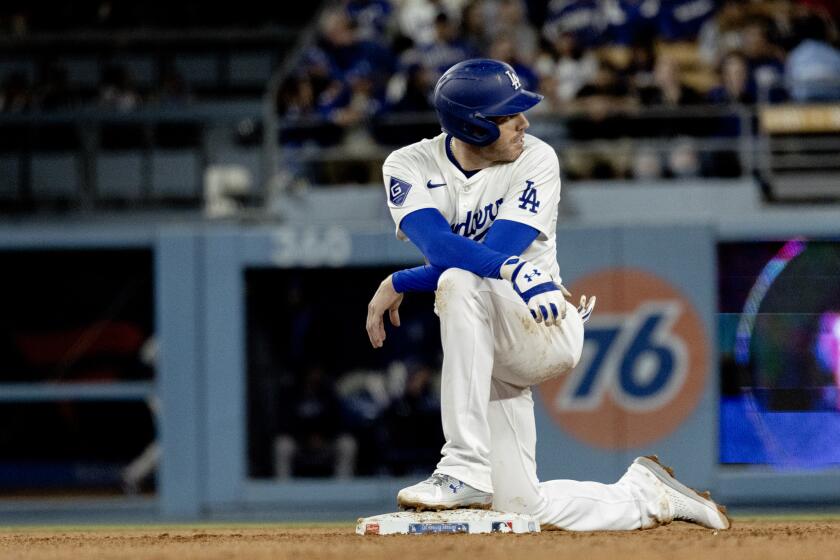Error Will Outweigh All Buckner Hits
Bill Buckner has 2,553 major league hits. Only 61 players in baseball history have more.
Billy Buck is a born hitter. He has 471 two-base hits. Only 40 players in history have more. Only one of them, Ted Simmons, is active.
You can’t strike him out. He could get wood on a mosquito. He fanned only 25 times in 681 at-bats last season. Some guys do that in a week.
He has scored 1,034 runs, which put him on another all-time ladder, right on the spoor of the game’s immortals.
But you know what it’s going to say in his obit? “Billy Buckner, who booted a routine ground ball in the bottom of the 10th in the 1986 World Series to give the New York Mets the victory . . . “
Move over Fred Merkle, Roy Riegels, Fred Snodgrass, Mickey Owen, Willie Davis, Ernie Lombardi, all you guys who merit an, “Oh yeah, I remember him. Isn’t he the guy who . . . ?”
Every World Series has its goat. Usually a guy who bats 150 points under his normal average, or goes 0 for 21, or serves up a home run ball to Bill Mazeroski. There was a third baseman once who chased the winning run across the plate in a rundown.
But only supergoats kick a ball in the bottom of an extra inning with the whole world watching on TV.
There’ll be no mention of Billy’s 2,500-plus hits. There’ll be no mention of the 15,000 balls he didn’t boot, or of the putouts and assists that went smoothly.
Forgotten will be the wild pitch the Boston pitcher threw one pitch before, letting in the tying run and putting the winning run in scoring position. You get two free trips to Acapulco if you remember his name.
No, it’s Buckner who gets the horns because, on the very next pitch, Mookie Wilson tapped a roller down the first-base line that you could have picked up with tweezers. Buckner never got his glove down to it. He played a hop that never hopped.
It’s a funny thing. If you stop people on the street and they’re baseball fans, two out of three will remember the incident as happening in the seventh and decisive game. It didn’t. It occurred in the decisive game, all right, but it was the sixth. It let the air out of the Red Sox.
The circumstances were these: the Boston Red Sox had gone ahead, 5-3, in the top of the 10th when Dave Henderson hit a home run, Wade Boggs a double and Marty Barrett a single.
There were two out and nobody on in the bottom of the inning when the Mets’ pulse fluttered faintly. Gary Carter singled. Then Kevin Mitchell and Ray Knight singled, too, and with the score 5-4, Boston brought in Pitcher Bob Stanley to quell the uprising. On a 2-2 count, he uncorked a wild pitch.
A pretty good case could be made that this was the really damaging gaffe of the World Series. It allowed Mitchell to score the tying run and put Knight, representing the winning run, on second base.
Then, with two out and a 3-2 count on Wilson, Knight was running with the pitch. When the ball went through Buckner’s legs, it was an easy matter for Knight to score the winning run.
But no one is going to want to listen to any long, drawn-out explanations. If Billy Buck even stops that ball, the game--and maybe the Series--is not all but over.
The public, though, deals in simplicity. Billy Buck comes into focus, now and forever, with this little trickler marked “world championship” rolling between his legs. Billy is standing there in those funny little shoes, looking into his glove like Charlie Chaplin.
The fans like their images and myths uncomplicated by either mitigating circumstances or facts in general.
What does this do to Billy Buck?
Well, it might surprise you to know that Fred Merkle, who committed his classic, pennant-costing blunder of failing to touch second base in 1908, played for 18 more years, 12 of them regularly.
Fred Snodgrass, who dropped a fly ball in the 1912 World Series, hung around for four more seasons.
Mickey Owen, who dropped the third strike that would have ended Game 4 and tied the 1941 Series, drifted around the majors for seven more years.
Ernie Lombardi, who lay prone at home plate in the 10th inning of the final game of the 1939 Series while three Yankees scored over him, played for eight more years. Fans forget that errors by his teammates, Billy Myers and Ival Goodman, put those runners on base.
Willie Davis, who booted three in one inning in the Series game that was the last game Sandy Koufax ever pitched, played for 11 more years.
Billy Buckner is not the type to brood, either. Billy’s stock in trade in the game has always been defiance. Throw the ball, I’ll hit it.
He has played the game under the direst of physical conditions for more than a decade.
You see, Bill Buckner’s ankles just weren’t built for the wear and tear of 17 major league seasons. He has rolled up 2,260 major league games on ankles that have been operated on so many times Billy is the only guy in the game with cauliflowered feet. He is one of the most recognizable athletes in the game because the high-cut shoes he wears make him look as if he could cross a channel in them.
He plays for the Angels now. The Red Sox let him go.
“They booed me opening day. I knock in 217 runs for them in two years and they boo me!” Billy marvels, shaking his head.
He is batting .344 for the Angels. His home run with two on was the decisive blow in Wednesday’s 6-1 win over the Minnesota Twins.
None of that is new for Billy Buck. Neither is the fact that, because of his ankles, Buckner gets to the ballpark five hours before game time--”I get here at 2 p.m. for night games”--for ice and treatment. It anesthetizes his sore ankles until, usually, about the seventh inning. Then they start to ache again.
Billy likes being a designated hitter because the treatment lasts longer, but he played late innings for years on feet that felt as if they were on fire.
Don’t expect to see any of that in his epitaph. Baseball custom is inexorable. Billy is always going to be Bill Buckner, “who let in the winning run in the 1986 World Series when a ground ball off the bat of Mookie Wilson . . . “
That Bill Buckner. As in that Roy Riegels. Or that Fred Merkle.
More to Read
Get our high school sports newsletter
Prep Rally is devoted to the SoCal high school sports experience, bringing you scores, stories and a behind-the-scenes look at what makes prep sports so popular.
You may occasionally receive promotional content from the Los Angeles Times.






